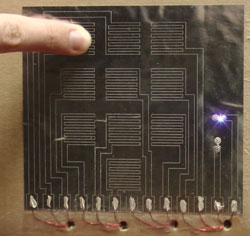May 11, 2012
 |
| The researchers have already develop an alarmed box with a keypad that requires a code to allow authorised access |
Researchers in the US and France have developed a paper-based electronic touch pad, opening the way for low cost, throwaway touch pads to be incorporated into anything from food packaging to disposable or sterile medical devices.
The touch pads are made from metallised paper - paper coated in a layer of aluminium around 10nm thick, which is overlaid with a thin film of transparent polymer. The paper is produced commercially and is used for shiny labels on beer bottles, or for glossy book covers, for example. And it is inexpensive at around $0.25/m2.
'We are interested in designing systems that use low cost materials to provide high-tech functionality,' says lead researcher Aaron Mazzeo, who works in the lab of George Whitesides at Harvard University, US.
The key to the system is that the paper has the essential elements of a capacitor - two surfaces of the thin metal film can be easily placed in proximity with a small gap between them. The team demonstrated two configurations of capacitor. One requires two sheets of the paper to be stuck together, with a 'horizontal' gap between the metal surfaces; the other uses only a single sheet, with a 'vertical' gap cut through the conducting surface. 'We use a laser cutter to ablate through the conductive layer to create distinct regions of conductivity on the metallised paper,' explains Mazzeo. Using the laser it is possible to cut a number of individual capacitors within the surface, each corresponding to a key on the pad. The keys are then linked to an external source of power and to electronic circuitry to detect when a given key is touched.
The human body itself acts as a capacitor and when a finger touches one of the keys there is a significant increase in capacitance at the key, detected by the external electronics. Mazzeo says that the paper touch pad will really come into its own when the power source and associated electronics also become cheap, flexible and disposable. Nevertheless, there could still be applications for the touch pad as it stands. One possibility would be for security on packaging. A cardboard box could incorporate a touch pad, with the electronics - retrievable and reusable - inside. The box could be opened legitimately only if the correct code was keyed in, otherwise the internal chip would detect interference. 'Other possibilities could include using the touch pads in sterile or contaminated medical environments,' Mazzeo suggests.
Commenting on the work, Khasha Ghaffarzadeh, an expert in printed electronics for the technology consultancy IDTechEx in Cambridge, UK, says: 'This is a very interesting piece of work. But as the authors also point out, the limiting factor will be the read-out electronics, which currently cannot be integrated onto paper-based products with favourable performance or price points.'
Source: Chemistry World
Additional Information:
- A D Mazzeo et al, Adv. Mater., 2012, DOI: 10.1002/adma.201200137
0 comments:
Post a Comment